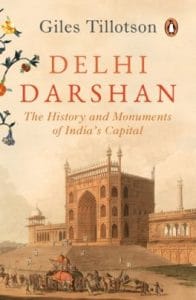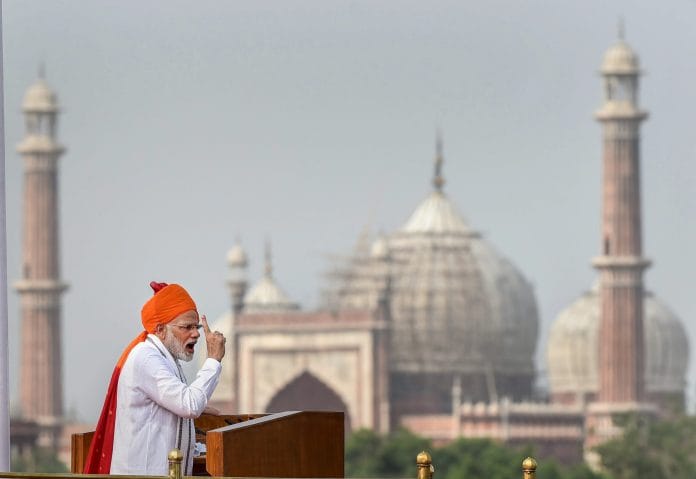We emerge into a sunlit space that was once an enclosed square and a crossroads. Level with this point a broad street ran from left to right across the whole width of the fort, down to the Delhi Gate on the southern side. Looming on our left are the British barracks that saddened the heart of the architectural historian James Fergusson, but which are now restored and cherished as relics of one period of the [Red] Fort’s history. Straight ahead stands a stately red sandstone pavilion known as the Naqqar Khana, after the drummers’ chamber that was housed in its upper storey. A common feature in Indian palaces, a naqqar khana was where musicians assembled to help proclaim arrivals and departures and to signal the passing phases of the day. François Bernier found the sound hard to get used to:
To the ears of an European recently arrived, this music sounds very strangely for there are ten or twelve hautboys, and as many cymbals, which play together . . . On my first arrival it stunned me so as to be insupportable: but such is the power of habit that this same noise is now heard by me with pleasure; in the night, particularly, when in bed and afar, on my terrace this music sounds as solemn, grand, and melodious.
The Naqqar Khana is also a gateway that gives access to a much larger space, originally lined by arcades, terminating in the grandest room of the palace, the Diwan-i-Am or the hall of public audience. Open on three sides, it is composed of columns and arches of red sandstone with an elevated marble throne balcony against the back wall. Inlaid in the wall behind are panels of Italian pietra dura, which were removed to the South Kensington Museum after the 1857 Rebellion but restored in 1903 on the insistence of Lord Curzon, in time for the Delhi Durbar of that year. Despite the high finish of the dressed red stone and the delicacy of the carved ornament, Bernier tells us that the columns were originally painted; and depictions of the hall dating from the late eighteenth and early nineteenth centuries seem to indicate that it was plastered and white. Bernier also tells us how the room was used:
The Monarch every day, about noon, sits upon his throne, with some of his sons at his right and left; while eunuchs standing about the royal person flap away the flies with peacocks’ tails, agitate the air with large fans, or wait with undivided attention and profound humility to perform the different services allotted to each. Immediately under the throne is an enclosure, surrounded by silver rails, in which are assembled the whole body of Omrahs [nobility], the Rajas [regional rulers], and the Ambassadors, all standing, their eyes bent downward, and their hands crossed. At a greater distance from the throne are
the Mansebdars [officials] or inferior Omrahs, also standing in the same posture of profound reverence. The remainder of the spacious room, and indeed the whole courtyard, is filled with persons of all ranks, high and low, rich and poor, because it is in this hall that the King gives audience indiscriminately to all his subjects.
This idea of the emperor’s connection with the people is reinforced by the architectural geometry. A single straight line runs like a thread from the foot of the throne balcony, via the Naqqar Khana and the Chatta Chowk, to the Lahore Gate and beyond, down the principal thoroughfare of the city. It is a line of connectivity, implying the penetration of the emperor’s gaze over his citizens, but also conversely suggesting his accessibility to them.
The scale and the obvious symbolism of this strict geometry raise a question about the buildings situated beyond the throne. Immediately behind the Diwan-i-Am lie the remains of a formal garden, facing the pavilion known as the Rang Mahal. With its carved marble basins and fountains, this large hall was the most luxurious of the palace’s private apartments. It is always described as the principal building of the zenana. But can this be correct? The Rang Mahal stands on the same all-important axis, implying a function connected with the emperor personally. Mughal women are known to have been influential in court politics; but it seems unlikely that this symbolically charged spot was assigned for their use.
Some of the earliest surviving depictions of the fort perhaps indicate an answer. Views of the palace apartments as seen from the riverside are typical of paintings made by local artists in the early nineteenth century. Often, the names of the buildings, written in Persian, are inscribed in the sky above them. But in these early works there is no ‘Rang Mahal’. The building in question is clearly depicted and is labelled ‘Khas Mahal’, indicating that it was the private apartment of the emperor himself. The adjacent building (the one that everyone now calls the Khas Mahal) is labelled ‘Saman Burj’ (octagonal bastion).
The identification of the so-called Rang Mahal (sometimes also called the Imtiyaz Mahal) as the women’s quarters is accepted by modern authorities, so it is worth investigating how and when this idea arose. The earliest expression of it that I have found occurs in an essay on the buildings of Delhi written in 1846 by the distinguished Muslim reformer, Syed Ahmad Khan. Around the same time (in 1838) the English traveller Fanny Parks was permitted to visit the room. She records that she saw ‘three old women on charpais, looking like hags; and over the marble floor, and in the place where fountains once played, was collected a quantity of offensive black water, as if from the drains of the cook rooms’. English readers might have inferred from this passage (published in 1851) that the apartment was part of the zenana. But Parks was describing life in the palace at a time when Mughal fortunes were at their lowest ebb, with various members of the extended imperial family eking out a squalid existence. She can tell us nothing about the Mughal court in its heyday.
Of course, the paintings don’t date from the heyday either. They were made 150 years after Shah Jahan’s death. But they predate both Fanny Parks and Syed Ahmad Khan and show us what was believed earlier: that the finest of the palace apartments, located behind and in line with the throne, was reserved for the emperor’s personal use.
Also read: Remembering the Red Fort trials that tipped India towards complete freedom
The other private apartments are strung out in a line that runs from north to south, perpendicular to the axis described above, perched on the ramparts of the fort wall, overlooking the space where the river once flowed. Each is a gem in its way but outstanding in splendour is the Diwan-i-Khas, the hall of private audience. Even though it’s smaller than the hall of public audience, it is no less magnificent and even richer in inlaid ornament. And though equally intended for ceremony and display, this room was also a place of work, where the emperor conferred with ministers and advisers. The nobles were required to assemble here each evening (and were fined for non-attendance) to assist the emperor as he deliberated on affairs of state. On occasion he might have preferred the greater seclusion and privacy of the Turkish baths next door. Indeed the identity of the two adjacent apartments seems to have become conflated, as Bernier calls the Diwan-i-Khas the ‘gasl khana’, meaning bathroom.
The arcades that enclosed a courtyard in front of the Diwan-i-Khas, below the podium, were among many parts that were lost in the wanton destruction carried out by the British after 1857. Earlier paintings may help us reconstruct parts of the palace in our minds, but the many changes carried out then make the complex hard to read. So does the slow pace of modern conservation, as the hammam, or Turkish baths, and the nearby exquisite Moti Masjid, or pearl mosque, are almost always closed. But some traces of the former atmosphere and beauty of the place are perhaps to be found in the Hayat Bakhsh Bagh, the formal garden at the northern end.
The dilapidated state of the complex is surprising in view of the iconic status that the fort holds in Indian hearts and minds. For the Lal Qila has become, at least in the eyes of the city’s residents, a symbol of Delhi—perhaps even of India (after the Taj Mahal). Images of it once featured prominently on postage stamps. But its elevation to that status was not by means of the obvious process. You might fairly think that it could have achieved its iconic role on its own merits: it is an architectural masterpiece built by a great Indian imperial power in a city that has served as a capital for 800 years or more. But in today’s political climate, this particular imperial power can no longer take for granted admiration for its achievements. In 2015, the name of one Mughal emperor, Aurangzeb, was unceremoniously removed from a road in central New Delhi. The Mughals alone could not make the Red Fort stand for all of India. They got help of a kind—clumsy or at best unintentional—from the British. Help came in two phases. First of all, the vandalism carried out in 1857 after the suppression of the rebellion made it—if not at the time then later, as those actions were viewed retrospectively—into a site of national resistance.
Compounding the offence ninety years later, in November 1945, the Red Fort was selected as the venue for the court martial of Shah Nawaz Khan, Prem Sahgal and Gurbaksh Singh Dhillon. These were three token individuals, selected from the many thousands of Indian officers and troops who had joined the Indian National Army and fought against the British during the Second World War. Initially fighting on the British side, they had been taken prisoner by the Japanese in Malaya, and agreed to change allegiance. Freed from jail, they joined the newly constituted INA and assisted the Japanese attack on Burma in 1945. Many members of the INA were captured by the British during that campaign. The trial of three of the officers, on charges of ‘waging war against the king’, provoked huge public anger, and their defence by a committee established by the Indian National Congress cemented public opinion in their support.
In the light of these events it is perhaps no wonder that the anniversary of India’s Independence, achieved less than two years later, is marked annually by a speech by the prime minister standing on the ramparts of the same Red Fort. Every year on 15 August, the serving prime minister mounts Aurangzeb’s barbican to address the cameras, looking down on a crowd of schoolchildren dressed in the colours of the flag, who brave the drizzle and enliven the tarmac.
 This excerpt from Delhi Darshan by Giles Tillotson has been published with permission from Penguin Random House India.
This excerpt from Delhi Darshan by Giles Tillotson has been published with permission from Penguin Random House India.







Reading and understanding this article is as difficult as reading and pronouncing the name of the writer. Please do not drive away ardent followers of print like me. In this age of speed, ask your writer to go straight to the point.